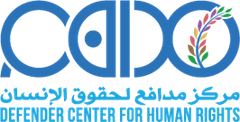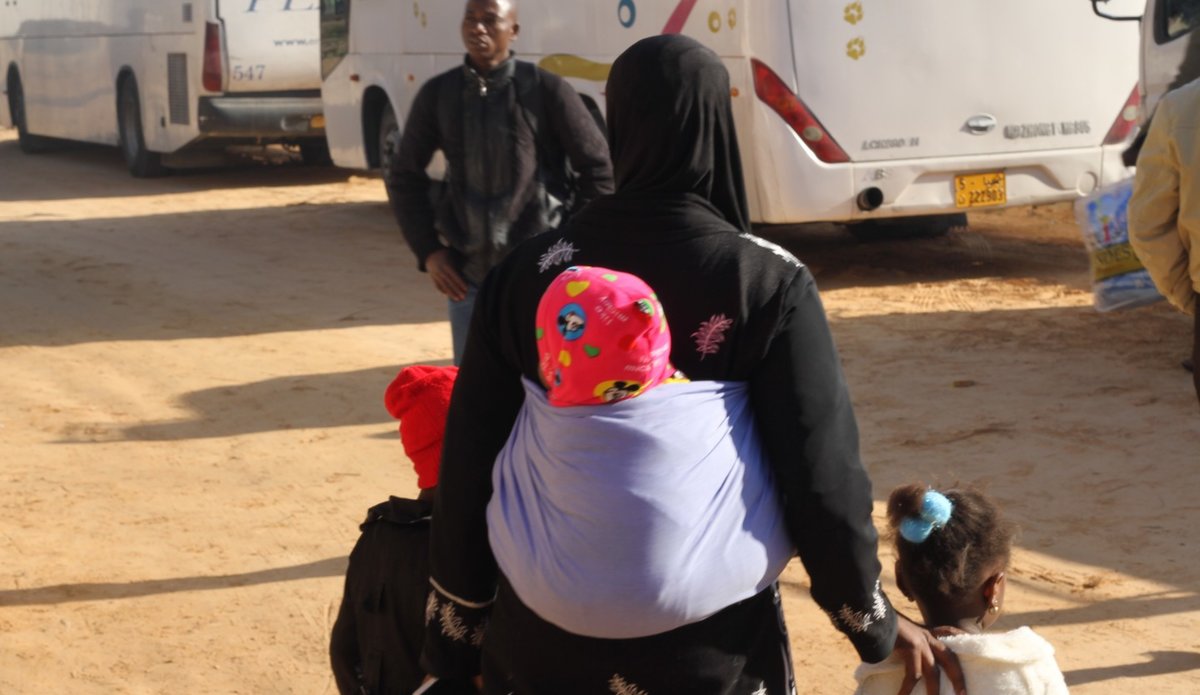Gender-based violence inside the displacement camps in Libya
Maram Mohammed [i]
Introduction
Since 2011, Libya has witnessed multiple waves of displacement, which resulted from the outbreak of the several armed conflicts in different regions. However, the destination and duration of displacement differed each time. According to the reports of the International Organization for Migration (IOM) on the internal displacement resulting from military conflict in the country during the years 2019-2020, schools (32%) were the most common type of buildings or places that the displaced took as their residence, followed by living with host families (30%), staying in rented properties (29%) and temporary shelters (2%). It is worth noting that these statistics were based on the data of the National Displacement Registration System of the Ministry of State for Displaced People’s Affairs. However, given the patterns of long-term displacement during which the displaced were not able to return to their homes even after the end of the conflict due to its devastating effects -, camps are the most common type of residence for displaced people. This has been witnessed in the case of practically forced displacement of peoples from the Tawergha and Kikla regions.
According to the United Nations High Commissioner for Refugees, the number of displaced people from Tawergha is estimated at 35,000 all over Libya, and despite the peace agreement and according to IOM, the number of families who tried to settle in the city of Tawergha did not exceed 100. Some of them have dispersed in different areas, but the majority are still distributed between camps in Tripoli (the Naval Academy camp, Al-Falah camp 1, Al-Falah camp 2, and families distributed in the buildings of the Islamic Call Society) and the Benghazi camps (Garyounis, Al-Riyadiah, Al-Hallis, Al-Anabeeb, Bouhdima)
Since 2011, residents of displacement camps have been subjected to repeated attacks and violent incidents, especially in the western region of the country, by militias and armed groups affiliated with the authorities. The violations of the displaced people’s human rights include kidnapping, killing, and enforced disappearance. However, these patterns of violence are not the only incidents in the camps. Other types of violent practices occur within those camps and do not receive attention from officials, and are not even mentioned when authorities speak about the plight of the displaced in the camps. In this context, we begin to see incidents such as the one reported in the Tripoli Security Directorate’s post on March 2, 2021, on its official Facebook page under the title ‘Arresting a harasser in the displacement camp’, in which it announced that it had “arrested someone for allegedly harassing his wife’s daughter, who came forward. A complaint against him that he harassed and attempted to rape her by force inside the Tawergha camp, and forcibly stripped her of her clothes, but she was able to escape from him and attend the center … “. The Tripoli Security Directorate indicated in the same publication that the phenomenon of sexual harassment is not limited to a specific region (or camp), but has become a general issue. It is known that in emergency and disaster situations, especially in displacement camps, rates of gender-based violence against women and girls are high and its patterns vary. However, there are no real statistical figures for the cases of violence against displaced women, whether inside or outside the camps. As a result of the failure to report these cases for various reasons, related to the survivors’ fears and lack of confidence in the security and social sector workers and the cultural attitudes in blaming the victim; survivors of such violence and their families could be subjected to social stigma and severe psychological impact because of the absence of post-incident victim protection schemes and lack of legal and social safeguards.
Response plans
As mentioned above, there is a lack of statistics on the number of survivors of gender-based violence inside or outside the camps, and because displaced women represent a group of marginalized and vulnerable groups, the organizations working in the humanitarian sector place them in their humanitarian response plans in Libya. Among the 153,000 people who suffer from the risk of violence based on Gender, the United Nations Office for the Coordination of Humanitarian Affairs (OCHA) partners will target help efforts toward 54,000 people, 60% of whom are women and 30% girls, including 16,000 in displacement camps and 1,000 people returning from displacement, according to the Humanitarian Response Plan announced in January 2021.
These responses by UN agencies is evident through the joining of efforts of the United Nations Development Program, the United Nations Support Mission in Libya, and the Ministry of Interior Affairs to respond to gender-based violence in Libya through training that provides male and female investigative officers with skills to integrate a gendered perspective while undertaking their work. On this occasion, the Deputy Director of the Tripoli Security Directorate, Mr. Abdel Hakim Samoud, stated: “Monitoring forms of violence within the family is among the responsibilities assigned to the Ministry of Interior Affairs to maintain peace and security in society. Through the Women’s Police Department and the Family and Child Protection Unit, the Ministry deals with domestic violence cases with the help of specialists. Moreover, it supports initiatives aimed at raising awareness of gender-based violence and improving the skills of its law enforcement officers’ response to such incidents”.
On International Women’s Day in 2019, the United Nations Population Fund with the support of France announced the launch of the hotline service “1417” through the implementing partner, the Psychosocial Support Team and under the supervision of the Ministry of Social Affairs. This service aims at providing psychosocial support services and legal advice on emotional violations and problems to families, vulnerable groups and survivors of gender-based violence.
A social worker[1] from the Psychosocial Support Team working in displacement camps says that the humanitarian response plans do not provide real solutions to survivors and that the most they can provide are psychosocial support services, despite the reporting of many incidents of violent practices against displaced women that need urgent intervention. Therefore, the majority of survivors do not want to continue participating in the sessions (which include psychological, social and legal counselling, referral and case management)[2], as they do not provide solutions to their security and financial needs for travel and access to health or daily living requirements and other needs, which is what prompts them to cope with the reality of the violence they are experiencing. Reporting these incidents would exacerbate their suffering and escalate the violence practiced against them, especially sexual violence or physical abuse. This makes the perpetrators more brazen-faced in repeating the violations and silencing victims in order to avoid prosecution.
The poor infrastructure of the camps encourages the perpetrators to commit these crimes, says one of the displaced women (a teacher who refused to reveal her name) in the Tawergha Naval Academy camp “shared and mixed toilets are used by the families living in every building and the bathroom door is not equipped with a lock. If there is a towel hanging it means men are inside, otherwise women are using the toilet. Many incidents of harassment occur even inside the building designated as a school due to the absence of teachers and the building not being equipped to be a safe environment. In addition, the lack of lighting between the different sections of the camp makes it extremely dangerous to move around after sunset. We know who is doing the harassment, but we need to educate the men in the camp.”
When I asked the social worker and the teacher about cases of domestic violence, they agreed that based on what is happening inside the camp, and through the interaction of women during awareness raising campaigns, that domestic violence is socially acceptable among families inside the camp, unlike other types of violence. In the displaced families’ view, domestic violence ‘contributes’ to raising girls and women and correcting their behavior. Clearly these families lack of awareness that these behaviors represent a type of violence.
Lack of awareness or social submission
The Libyan newspaper Al-Marsad published statements by the Minister of Justice that increased the disappointment of Libyan women and survivors of gender-based violence and demolished the ceiling of their aspirations for women’s representation by the National Unity Government. During her meeting with the UN representative for the Women’s Commission, the Minister said that Libyan laws do not discriminate between men and women and guarantee women their political, economic and social rights. One is not sure whether this untrue statement stems from her satisfaction with the legal position of women in Libyan legislation or whether it was a necessary politically correct statement in a patriarchal society.
The minister’s statements were met with strong denunciation by Libyan feminist defenders, considering that some legislation consecrates gender-based violence against women, which is evident even for those without legal expertise, let alone the Minister of Justice.
Finally, regarding the issue of gender-based violence it is evident that the awareness raising and activism on social media platforms is more courageous than the actions of organizations on the ground. More significantly, most of the awareness sessions and safe spaces designated for displaced girls and women do not target men, despite camp leaders welcoming the importance of educating men and boys about issues of gender-based violence, especially with the increase in the number of incidents of harassment and attacks inside the camps.
The lack of awareness that gender-based violence is a form of human rights violations increases its prevalence and normalization in culture and society, even at the level of decision-making. Therefore, concerted efforts must focus on:
- Centering the efforts of human rights activists on raising awareness of issues of gender-based violence, inside and outside the camps, as a violation of human rights (specifically women’s rights).
- The media should consider the stories of survivors as inspiration for other victims to come forward. Human rights, social and psychological experts should be employed when interviewing survivors in order to provide a safe space for them to speak about their stories. The media coverage should refrain from justifying crimes and blaming the survivors.
- Supporting and financing initiatives that aim to improve and maintain the camp’s infrastructure (electricity, water, toilets, etc.) to reduce opportunities for perpetrators.
- Civil society organizations should also work to monitor cases and publish numbers and statistics to shed light on the extent of this phenomenon in the camps.
- Supporting the efforts of women working in the field of gender-based violence, on increasing awareness of both men and women, conducting research, or providing services. Social workers should be protected while carrying out their work inside or outside the camps.
[1] The name is not disclosed to protect the social worker.
[2] Referral to another organization working in the context of gender-based violence using only the dedicated pathway between UN agencies and their partner organizations. As for case management, it is the approach or method of dealing with survivors of violence that is also adopted by the United Nations agencies and their partner organizations working in the field of gender-based violence for women and children in particular.
[i] Human rights activist.




Leave a Reply
Want to join the discussion?Feel free to contribute!